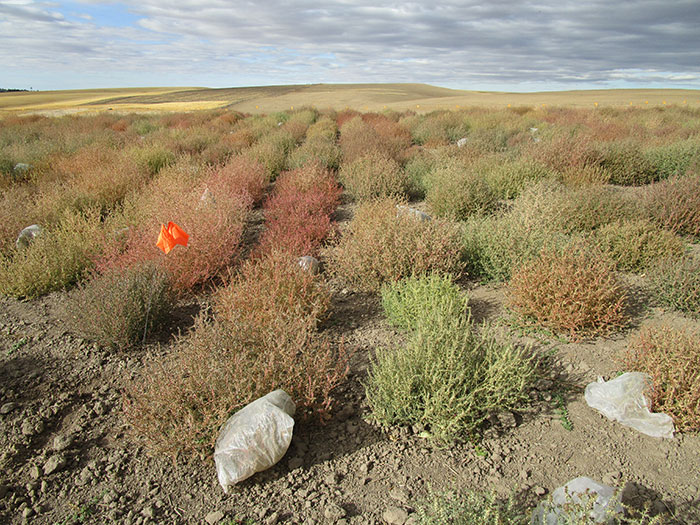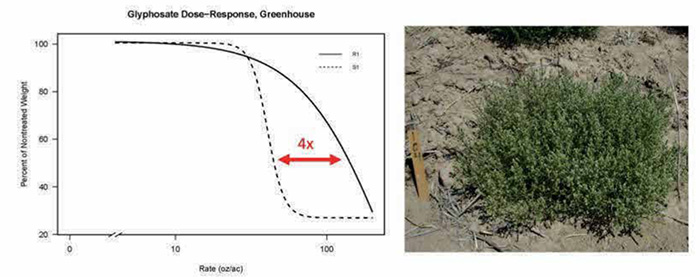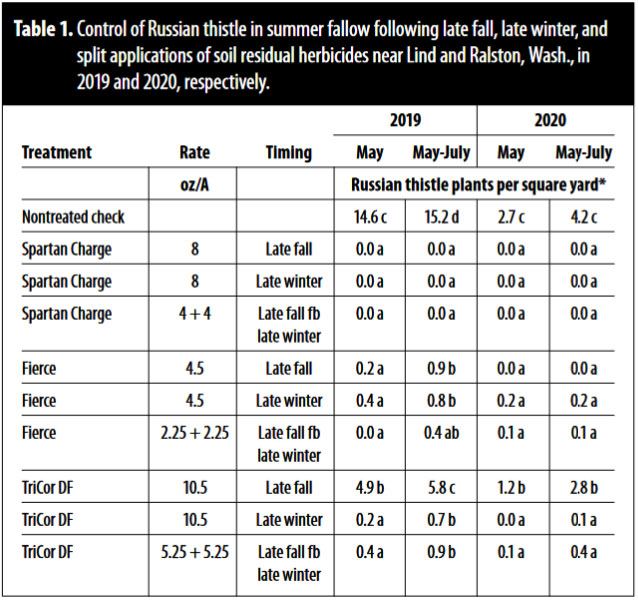Russian thistle biology and management in the Pacific Northwest
By Drew Lyon and John Spring
Russian thistle is an annual broadleaf weed that is found throughout Eastern Washington and exhibits a notable wide range of different growth forms, or phenotypes (Figure 1). It is most problematic in the lower rainfall region where the winter wheat-fallow rotation is common.
Russian thistle is thought to be native to the mountainous regions of southwest Asia. The first known introduction to North America was near Scotland, S.D., in 1873 or 1874, probably as a contaminant of flax seed imported by Russian immigrants. By 1895, several Canadian provinces and 16 western states were infested, with rapid spread often attributed to dispersion by wind and rail traffic. By 1910, Russian thistle was widely distributed across an estimated 100 million acres in the arid and semi-arid regions of the American West, including 4.5 million acres in the inland Pacific Northwest (PNW).
Russian thistle does not produce a true embryonic seed with endosperm; instead, it contains a coiled, fully developed seedling. Germination consists simply of uncoiling and can be quite rapid — taking just hours under favorable conditions. Germination can occur with relatively low moisture availability. Rapid germination allows Russian thistle to take advantage of short windows of favorable conditions that a slower-germinating species might be unable to exploit.

Flowering begins in midsummer with pollination primarily by wind. Seed production begins in August or September and continues through the first killing frost of the year, with viable seed produced by September or October. Estimates of seed production vary, with healthy plants producing between 40,000 and 100,000 seeds per plant. After plants die in the fall, they often break off at the base of the stem and become tumbleweeds. Plants shed approximately 60% of seed when tumbling and only 20% if remaining stationary. In a study near Lind, Wash., tumbling plants were observed to travel approximately 0.5 to 2 miles before becoming lodged in stubble, fencerows, ditches, or other obstacles, with maximum travel distances slightly over 2.5 miles observed over six weeks in early fall. Seed longevity in the soil is generally only one year.
The largest impact of Russian thistle in crops is direct yield loss resulting from competition for soil moisture. Healthy stands of winter wheat compete effectively with Russian thistle, and severe infestations generally occur only where stands are poor or plants are heavily stressed. In contrast, spring cereals are highly susceptible to infestation and often suffer severe reductions in yield — up to 50% in heavy infestations.
Although yield losses in spring wheat or poor winter wheat stands can be severe, postharvest and fallow-year growth of Russian thistle may have a larger cumulative impact on the overall cropping system than in-crop growth.
Following harvest of the wheat crop, Russian thistle quickly resumes active growth that continues through the first killing frost. If not controlled, this growth can result in substantial biomass accumulation, soil water use, and seed production. Biomass accumulation and soil water use by Russian thistle plants during this postharvest period substantially exceeds use during the crop growing season. Individual plants used approximately 18 gallons of soil water while growing in spring wheat and an additional 26 gallons of soil water for postharvest growth.
Management
In crop, the most effective management practice is ensuring a competitive crop. Healthy winter wheat stands provide effective control through competitive suppression. Although spring wheat is much less competitive with Russian thistle, early planting, using a starter fertilizer, and other agronomic practices that promote a vigorous crop stand can improve competitive suppression to some degree. Effective herbicide options are available for in-crop control. See the PNW Weed Management Handbook for options. Remember, herbicides work best
when applied to smaller plants, generally less than three to four inches in height.

In 2015, glyphosate-resistant Russian thistle was documented in Washington, Oregon, and eastern Montana. In a greenhouse screening, resistant plants collected in Eastern Washington were four times more resistant to glyphosate than susceptible plants. In a field study conducted at the Lind Dryland Research Station, resistant plants were eight times more resistant than susceptible plants (Figure 2). Growers have often relied on only glyphosate for the control of Russian thistle in fallow. This use pattern has resulted in the evolution of glyphosate resistance in Russian thistle throughout much of the inland PNW.
In 2019 and 2020, we conducted field studies near Lind and Ralston, respectively, to investigate the use of soil-applied residual herbicides to control Russian thistle in summer fallow. This has proved to be an effective strategy for the control of glyphosate-resistant kochia in the Great Plains. Three different herbicides (Spartan Charge, Fierce, and TriCor) were applied either in late fall, late winter, or as a split application with half the rate applied in late fall and another half rate applied in late winter. The full Spartan Charge rate was 8 fluid ounces per acre, the full rate of Fierce was 4.5 ounces per acre, and the full rate of TriCor was 10.5 ounces per acre.
In 2019, all treatments provided excellent control of Russian thistle at the first rating taken on May 15, except TriCor applied in the late fall (Table 1). Over the next month, Spartan Charge and Fierce applied as a split application and TriCor applied in late winter continued to provide excellent control of Russian thistle. On the final rating of July 9, only the Spartan Charge treatments, regardless of application time, were providing significantly better control than the nontreated check plots.
In 2020, all treatments were providing excellent control of Russian thistle on the initial May 14 rating date, except TriCor DF applied in the late fall (Table 1). Over the remainder of the trial period, all treatments continued to provide excellent control of Russian-thistle except TriCor DF applied in late fall or late winter; however, few seedlings emerged between the June and July sample dates.

The results of these two trials suggest that preemergence herbicides can provide an alternative or supplemental means of controlling Russian thistle in chemical fallow and may become necessary as glyphosate-resistant Russian thistle becomes more prevalent. While lateremerging flushes may not be controlled by residual herbicides, most of the plants that germinate in April and May should be, and this may simplify fallow management and allow a reduction in the total number of control operations required.
In 2022 and 2023, we looked at an experimental herbicide from BASF for postharvest Russian thistle control. The experimental herbicide (BAS 85101H) performed well both years. If or when it is registered, it will be a good tool to add to the mix of herbicides for postharvest Russian thistle control.
For more information on these and other herbicide trials, check out the annual WSU Weed Control Reports on the WSU Wheat and Small Grains website at https://bit.ly/3WQRsQh. You can also find PNW492, Russian Thistle: Management in a Wheat-Fallow Crop Rotation at extension.oregonstate.edu/catalog/pub/pnw-492-russian-thistle-management-wheat-fallow-crop-rotation
This article originally appeared in the June 2024 issue of Wheat Life Magazine.

Drew Lyon
Professor and Endowed Chair, Small Grains Extension and Research, Weed Science

John Spring
Former Graduate Research Assistant, Agronomist, Central Oregon Seeds, Inc.
